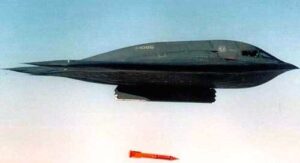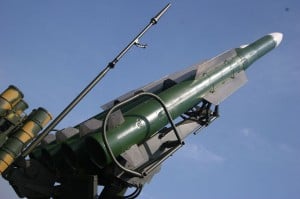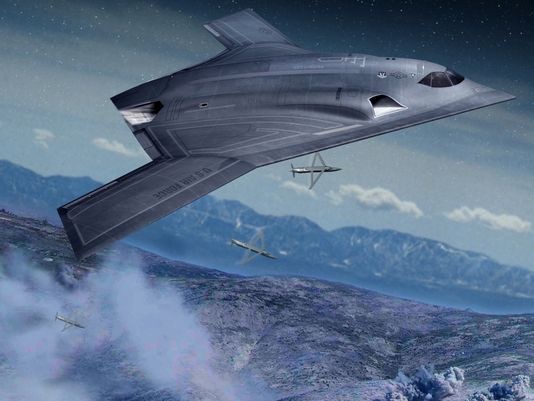Northrop Garners Huge Win With New Bomber; LRSB $564M Per Plane
Posted on
UPDATED with details from Pentagon press conference; corrected EMD contract value
PENTAGON: Affirming its status as the nation’s builder of stealthy bombers, Northrop Grumman today won what will probably be the biggest defense contract of the decade, the $80 billion, $564 million-per-plane Long-Range Strike Bomber program, which will enter service circa 2025.
“The LRSB will allow the Air Force to operate in tomorrow’s high-end threat environment, what we call anti-access/area denial,” said Air Force Secretary Deborah Lee James, making the announcement in the Pentagon briefing room. “It will also give us flexibility and the capability to launch, from the continental United States, airstrikes that would be able to strike any location in the world.”
With James was Gen. Mark Welsh, who signed off on the official requirements for the bomber shortly after taking office as Air Force Chief of Staff in 2012. Since then, “those requirements remained unchanged,” he boasted, which meant that both competitors could move ahead with actual design work, “achieving what I believe is a remarkable level of fidelity for this point in a new aircraft program.” Shifting requirements and incomplete designs are chronic problems that cause delays and cost overruns on Pentagon programs.
The Air Force leaders were preceded by Defense Secretary Ash Carter, who outlined the need for the aircraft. The LRSB initiative in fact arose from a joint review of strike requirements Carter led in 2011 when he Under Secretary for Acquisition, Technology, and Logistics, which concluded a “new and innovative design” was necessary. That means the bomber has buy-in at the highest level of the Defense Department.
An Incredibly Close Competition

Northrop Grumman’s B-2 bomber
It was what most observers saw as an incredibly close competition. In the end Northrop’s experience building and maintaining the B-2 stealth bomber, combined with its production facilities and sensor expertise (think the Distributed Aperture System on the F-35) appeared to nudge the company past the aerospace giants of the Boeing-Lockheed team.
If the two leviathans had won, Lockheed Martin, which is doing the design work for the Boeing-Lockheed team and building the F-35 stealth fighter, would have captured almost all of the country’s advanced stealth design work. But Frank Kendall — the head of Pentagon acquisition, who holds milestone decision authority over the program — said repeatedly that industrial base issues would play no role in the contract decision, something Air Force acquisition chief Bill LaPlante repeatedly reiterated today.
Besides their industrial might, Lockheed and Boeing together wield enormous political clout and so could have protected the program from all comers. It’s an open question whether Northrop, a much smaller entity, can do as good a job of beating back the critics who are already emerging. There’s also the strong possibility that Lockheed and Boeing will file a protest with the Government Accountability Office (GAO), holding up the program for a 100-day review: The Air Force will brief the losers as early as Friday.
Assuming the Northrop victory isn’t overruled by GAO, the nation has two design teams able to work on stealthy aircraft. At the same time, bomber stealth work is considerably different from fighter work such as that done by Lockheed Martin on the F-35, as it must cover the whole aircraft in all directions against advanced enemy radars.

Russian “Beech” (Buk) surface-to-air missile launcher.
Meeting The Threat
The bomber program has gained momentum as the threat rose in the last five years and our existing fleet aged. China and Russia, in particular, are investing heavily in what the military calls anti-access/area denial (A2/AD) weapons such as advanced surface-to-air missiles, radars, and electronic warfare systems to defeat US airpower.
Rep. Randy Forbes, chairman of the House Armed Services seapower and power projection subcommittee, laid out the basic argument for a new bomber in a recent opinion piece he wrote for Breaking Defense:
“Long-range bomber aircraft have been a central element of America’s power projection forces since the Second World War. But after several decades of relative neglect, the Air Force’s bomber fleet is now the smallest and oldest it has ever been. Overall, our 159 bombers have an average age of 39 years—older than most of their pilots—and less than half of the force is ‘mission capable’ in at least one mission area. Of these aircraft, only 20 B-2s are ‘stealth bombers’ capable of penetrating the integrated air defense systems being fielded (and exported abroad) by countries like Russia and China. Our 139 older B-1 and B-52 bombers, meanwhile, are best suited for operating in low-threat environments and launching standoff missile strikes.”
Air Force Sec. James made much the same argument. “The world has observed our application of airpower over the last 25 years [since the Gulf War],” she said. “As a result,[we’ve seen] the introduction of advanced air defense systems and the development of much more capable surface to air missile systems, which effectively push our older bombers, the B-52 and the B-1 with an age of 50-plus years and 27-plus years respectively, farther and farther from the fight.”
The Long-Range Strike Bomber is meant to restore the American ability to fly into the teeth of enemy defenses.
By The Numbers
Today’s award has two parts: a cost-plus contract for Engineering & Manufacturing Development (EMD) and a fixed-price contract for 21 bombers. [The estimated cost of the EMD phase is $21.4 billion. (An earlier version of this story misstated that figure as the contract value, which in fact wasn’t released).]. The cost per plane wasn’t given, but for the first 21 aircraft, which would be more expensive than those later in the production run, it would presumably be higher than the $564 per million figure, which is the average over 100 aircraft. In addition, the program’s already been appropriated $1.9 billion for “risk reduction” work to get technologies ready for prime time.
Kendall has told reporters that the Pentagon will compete upgrades “during” the bomber program. Since the initial bomber will not be nuclear-capable, the nuclear upgrade might be when the other upgrades are done. Or it may come after the first 21 planes. We’ll see.
LaPlante told reporters that the Average Procurement Unit Cost (APUC) cost of the bomber is $511 million per aircraft in fiscal year 2010 dollars. That cost in 2016 dollars is $564 million per plane. (No details were offered on the engines’ cost). This price beats the target set in 2011 by then-Defense Secretary Robert Gates: $550 million in 2010 dollars, which is $606 million in 2016 dollars.
“We believe these estimates are reasonable and achievable,” said LaPlante. In fact, “if we remain disciplined and keep program requirements stable, we can believe we can beat these estimate.”
The cost estimates came from solid, independent sources, not in-house wishful thinking by the bomber program, Air Force officials emphasized. “There were two independent cost estimates actually done on the program, one by Air Force Cost Analysis Agency and the other by OSD Cost Assessment and Program Evaluation group,” said Lt. Gen. Arnold Bunch, military assistant to LaPlante. Both used real historical data from past programs as their baseline. In the end, Bunch said, “those two numbers were within two percent of each other, and we the Air Force budgeted to the higher or more conservative of those — which was the Air Force estimate.”

Rep. Jackie Speier
Convincing Congress
The Air Force will have an uphill job convincing Congress its numbers are trustworthy. The first critique came in half an hour of the announcement, from Rep. Jackie Speier, the top Democrat on the House Armed Services oversight and investigations subcommittee.
“We need to keep the Long-Range Strike Bomber on track and hold the Pentagon to its promise of delivering a tested, reliable airplane for $550 million a copy [in 2010 dollars],” Speier said in a statement. “The Rapid Capabilities Office has made some good decisions to use proven technology and accept the recommendations of independent weapons testers and auditors in their development process. But there are warning signs, including a clerical discrepancy that resulted in a $16.7 billion misreporting error to Congress.”
“It’s Congress’s job to ensure the process doesn’t go south—especially as we begin looking under the hood and approaching potential risk areas like systems integration and future weapons development,” Speier said. “We must avoid the acquisition malpractice that has shortchanged our national defense in so many other instances.”
Subscribe to our newsletter
Promotions, new products and sales. Directly to your inbox.

